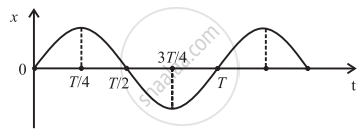Advertisements
Advertisements
Questions
Answer in brief.
Using differential equations of linear S.H.M, obtain the expression for (a) velocity in S.H.M., (b) acceleration in S.H.M.
State the differential equation of linear S.H.M. Hence, obtain the expression for:
- acceleration
- velocity
Solution
Differential equation of SHM
∴ `(d^2x)/(dt^2) + omega^2.x = 0` ............(i)
(a) Obtaining expression for acceleration:
`(d^2x)/(dt^2) = -omega^2.x` ........[From (i)]
But `a = (d^2x)/(dt^2)` is the acceleration of the particle performing SHM.
∴ a = `-omega^2.x`
This is the expression for acceleration.
(b) Obtaining expression for velocity:
`(d^2x)/(dt^2) = -omega^2.x` ..............[From (i)]
∴ `d/dt((dx)/(dt)) = -omega^2.x`
∴ `(d"v")/(dt) = -omega^2.x`
∴ `(d"v")/(dx)(dx)/(dt) = -omega^2.x`
∴ v`(d"v")/(dx) = -omega^2.x`
∴ v.dv = -ω2.x.dx
Integrating both sides, we get
`int"v".d"v" = -omega^2intx.dx`
∴ `"v"^2/2 = -omega^2.x^2/2 + C` ...........(iii)
Where C is the constant of integration.
Let A be the maximum displacement (amplitude) of the particle in SHM.
When the particle is at an extreme position, velocity (v) is zero,
Thus, at x = ±A, v = 0,
Substituting v = 0 and x = ±A in equation (ii), we get
∴ `0 = -omega^2. A^2/2 + C`
∴ C = `omega^2.A^2/2`
Using the value of C in equation (ii), we get
∴ `"v"^2/2 = -omega^2.x^2/2 + omega^2.A^2/2`
∴ `"v"^2 = omega^2(A^2 - x^2)`
∴ v = `±omegasqrt(A^2 - x^2)`
This is the expression for velocity.
RELATED QUESTIONS
Choose the correct option:
The graph shows variation of displacement of a particle performing S.H.M. with time t. Which of the following statements is correct from the graph?

Find the change in length of a second’s pendulum, if the acceleration due to gravity at the place changes from 9.75 m/s2 to 9.8 m/s2.
A particle is performing S.H.M. of amplitude 5 cm and period of 2s. Find the speed of the particle at a point where its acceleration is half of its maximum value.
The light of wavelength '`lambda`'. incident on the surface of metal having work function `phi` emits the electrons. The maximum velocity of electrons emitted is ______.
[c = velocity of light, h = Planck's constant, m = mass of electron]
For a particle performing SHM when displacement is x, the potential energy and restoring force acting on it is denoted by E and F, respectively. The relation between x, E and F is ____________.
A wheel of M.I. 50 kg m2 starts rotating on applying a constant torque of 200 Nm. Its angular velocity after 2.5 second from the start is ______.
A particle is moving along a circular path of radius 6 m with a uniform speed of 8 m/s. The average acceleration when the particle completes one-half of the revolution is ______.
A body performing a simple harmonic motion has potential energy 'P1' at displacement 'x1' Its potential energy is 'P2' at displacement 'x2'. The potential energy 'P' at displacement (x1 + x2) is ________.
The relation between time and displacement for two particles is given by Y1 = 0.06 sin 27`pi` (0.04t + `phi_1`), y2 = 0.03sin 27`pi`(0.04t + `phi_2`). The ratio of the intensity of the waves produced by the vibrations of the two particles will be ______.
Which of the following represents the acceleration versus displacement graph of SHM?
A particle executing S.H.M. has amplitude 0.01 m and frequency 60 Hz. The maximum acceleration of the particle is ____________.
The displacement of a particle is 'y' = 2 sin `[(pit)/2 + phi]`, where 'y' is cm and 't' in second. What is the maximum acceleration of the particle executing simple harmonic motion?
(Φ = phase difference)
The maximum speed of a particle in S.H.M. is 'V'. The average speed is ______
The length of the second's pendulum is decreased by 0.3 cm when it is shifted from place A to place B. If the acceleration due to gravity at place A is 981 cm/s2, the acceleration due to gravity at place B is ______ (Take π2 = 10)
A simple pendulum of length 'L' is suspended from a roof of a trolley. A trolley moves in horizontal direction with an acceleration 'a'. What would be the period of oscillation of a simple pendulum?
(g is acceleration due to gravity)
The bob of a simple pendulum is released at time t = 0 from a position of small angular displacement. Its linear displacement is ______.
(l = length of simple pendulum and g = acceleration due to gravity, A = amplitude of S.H.M.)
A body perform linear simple harmonic motion of amplitude 'A'. At what displacement from the mean position, the potential energy of the body is one fourth of its total energy?
A particle is performing SHM starting extreme position, graphical representation shows that between displacement and acceleration there is a phase difference of ______.
In figure, a particle is placed at the highest point A of a smooth sphere of radius r. It is given slight push and it leaves the sphere at B, at a depth h vertically below A, such that h is equal to ______.

The displacement of a particle of mass 3 g executing simple harmonic motion is given by Y = 3 sin (0.2 t) in SI units. The kinetic energy of the particle at a point which is at a distance equal to `1/3` of its amplitude from its mean position is ______.
In the given figure, a = 15 m/s2 represents the total acceleration of a particle moving in the clockwise direction on a circle of radius R = 2.5 m at a given instant of time. The speed of the particle is ______.

For a particle performing circular motion, when is its angular acceleration directed opposite to its angular velocity?
State the expressions for the displacement, velocity and acceleration draw performing linear SHM, starting from the positive extreme position. Hence, their graphs with respect to time.
State the expression for the total energy of SHM in terms of acceleration.
Which one of the following is not a characteristics of SHM?
